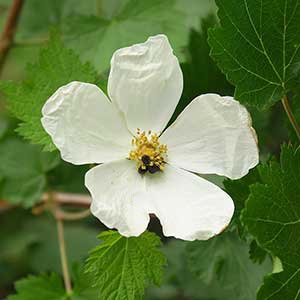Rubus bartonianus
Rubus ulmifolius
Barton's raspberry, bartonberry
elm-leaf blackberry
erect, sparsely short-hairy, glabrescent, eglandular, not pruinose.
biennial, erect, then arching, usually moderately, rarely sparsely, hairy hairs stellate, eglandular, strongly pruinose;
prickles absent or sparse to dense, erect to hooked, stout, 3–10 mm, broad-based.
deciduous, simple;
stipules lanceolate, 4–6 mm;
blade cordate to broadly ovate, (2–)2.5–4(–5) × (2.5–)3.5–4.5(–5.5) cm, base deeply cordate, 3–5-lobed, lobe apices acute to obtuse, margins coarsely doubly dentate, abaxial surfaces glabrous or sparsely hairy, eglandular or sparsely stipitate-glandular.
persistent or nearly so, ternate to palmately compound;
stipules filiform to linear, 4–12 mm;
leaflets 3–5, terminal ovate, elliptic, or suborbiculate to obovate, 4–10 × 2–6(–9) cm, base rounded to cuneate, unlobed, margins finely to moderately serrate, apex acute or acuminate to attenuate, abaxial surfaces with hooked prickles on larger veins, densely white short-velutinous, hairs usually minute, eglandular.
1-flowered.
terminal, 10–60-flowered, paniculiform or thyrsiform.
moderately hairy, eglandular or sparsely stipitate-glandular.
unarmed or prickles moderate to dense, erect to hooked, densely short-hairy, eglandular.
bisexual;
petals white, obovate, (15–)20–25 mm;
filaments filiform;
ovaries glabrous, styles clavate, villous.
bisexual;
petals usually pink, sometimes white, obovate or elliptic to suborbiculate, 5–12 mm;
filaments filiform;
ovaries apically hairy.
deep red, hemispheric, to 1 cm;
drupelets 10–30, coherent, separating from torus.
black, globose to ovoid, 1–1.5 cm;
drupelets 10–40, strongly coherent, separating with torus attached.
= 14.
Rubus bartonianus
Rubus ulmifolius
Of conservation concern.
Rubus bartonianus is distinguished from the other flowering raspberries within its geographic range by its erect, unarmed stems, relatively small, simple leaves with acute to obtuse lobes, deeply cordate bases, sparsely hairy or glabrous abaxial surfaces, relatively large flowers with white petals, and densely long-hairy, clavate styles. The leaves superficially resemble those of Acer glabrum or some species of Ribes.
Rubus bartonianus is most similar to R. neomexicanus but especially R. deliciosus. The species is known only from the Snake River Canyon of Idaho and Oregon.
(Discussion copyrighted by Flora of North America; reprinted with permission.)
Rubus ulmifolius can be distinguished, especially from the closely related R. bifrons and R. vestitus, by its strongly pruinose stems, finely serrate leaflets, and lack of glands throughout. Unlike R. ulmifolius, strongly pruinose native Rubus species lack relatively large and showy pink petals. Some new stems developing from tip-rooting, and early leaves on such stems (especially in shade), are not whitened abaxially and are tomentose. Such unusual stems develop typical leaves and surfaces in parts formed later.
There has been nomenclatural confusion over unarmed plants of Rubus ulmifolius (see E. Monasterio-Huelin and H. E. Weber 1996). Rubus inermis Willdenow is an illegitimate later homonym of R. inermis Pourret, and the type specimens for both names are of poor-quality. If an unarmed variety of R. ulmifolius is to be recognized, such as occurs in California, the name var. anoplothyrsus Sudre should be used instead of var. inermis (Willdenow) Focke.
Rubus ulmifolius is attractive and is potentially weedy but relatively uncommon, found primarily in coastal California from the San Francisco Bay region southward. It probably no longer persists in New Jersey, last collected there in 1897, and it is rare in Nevada and Oregon. Rubus ulmifolius likely hybridizes with R. bifrons where they co-occur; it is one of relatively few diploid and sexually reproducing species of European blackberries.
(Discussion copyrighted by Flora of North America; reprinted with permission.)
- Local floras:
CA,
OR,
WA
- Local Web sites:
CalFlora,
CalPhotos,
Flora NW,
PNW Herbaria
WildflowerSearch
iNaturalist (observations)
USDA Plants Database
- LBJ Wildflower Center
- SEINet
- Plants of the World Online
- Encyclopedia of Life
- Wikipedia
- Google Image Search


